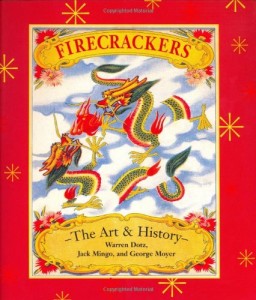 As a British friend of mine says, “Nothing gobsmacks me as much as a great fireworks show!” Have you ever seen a Guy Fawkes celebration? Or an American Fourth of July fireworks display? If you have, you know the appeal of these colourful displays. The authors have created a labour of love in producing Firecrackers: The Art & History, a book that literally covers all things pyrotechnic. Popular worldwide and loud enough to make a banshee quake in terror, firecrackers are little — and sometimes very big — sticks of paper with explosive powder therein. Firecrackers: The Art & History brings the tale of these fiendish devices to life, from their apparent invention in China to their current use in celebrations such as the aforementioned Fourth of July. The first full-color book ever published which includes the art of firecracker labels through the ages, Firecrackers: The Art & History is a major achievement in me opinion.
As a British friend of mine says, “Nothing gobsmacks me as much as a great fireworks show!” Have you ever seen a Guy Fawkes celebration? Or an American Fourth of July fireworks display? If you have, you know the appeal of these colourful displays. The authors have created a labour of love in producing Firecrackers: The Art & History, a book that literally covers all things pyrotechnic. Popular worldwide and loud enough to make a banshee quake in terror, firecrackers are little — and sometimes very big — sticks of paper with explosive powder therein. Firecrackers: The Art & History brings the tale of these fiendish devices to life, from their apparent invention in China to their current use in celebrations such as the aforementioned Fourth of July. The first full-color book ever published which includes the art of firecracker labels through the ages, Firecrackers: The Art & History is a major achievement in me opinion.
The very first firecrackers had no ‘demon powder’ in them, but rather were lengths of green (fresh) bamboo tossed into hot fires that exploded when the water trapped inside heated and exploded — similar to what popcorn does. Later, the Chinese used gunpowder in bamboo casings — and later in paper casings — to create what we now call firecrackers. At the turn of the 20th century firecrackers had become popular enough that there was competition among manufacturers, which led them to use colourful labels to lure buyers. Very quickly, the art of the firecracker label became an art form: labels became more highly designed, with the graphics depicting everything from gods and heroes to weddings, monkeys, and cowboys. (The earlier Chinese-constructed firecrackers had artwork depicting such traditional Chinese things as dragons, demons, fire dancers, and tigers. Later Chinese crackers used more American symbols such as Tarzan, cowboys, and airplanes of American design.) All of this imagery seems terribly strange until the authors point out that the consumers of firecrackers were the youth of America, and they were notorious for consuming fads, as they are today.
And this book’s full of trivia about its subject. Did you know that American newspapers were collected during community paper drives and shipped to China, where they were used as the paper wrappings for firecrackers? Or that Christmas, not the Fourth of July, was until the 1930s when firecrackers were set off in the American South?
The American Fireworks Network calls Firecrackers: The Art & History “[a] firecracker pack and label collector’s dream. Here is everything you need to know about firecracker history, label design, and how to rate a grade collector quality firecracker pack label.” I wholeheartedly agree! Warren Dotz, a Berkeley, California-based consultant and popular culture historian, Jack Mingo, a widely published humorist and commentator on popular culture, and George Moyer, who has one of the most extensive firecracker label collections in the U.S., have put together the definitive book on both the history of firecrackers and the art and collecting of firecracker labels. Firecrackers: The Art & History is sure to delight popular culture fans, art lovers, graphic designers, and anybody who likes things that go bang!
(Ten Speed Press, 2000)
